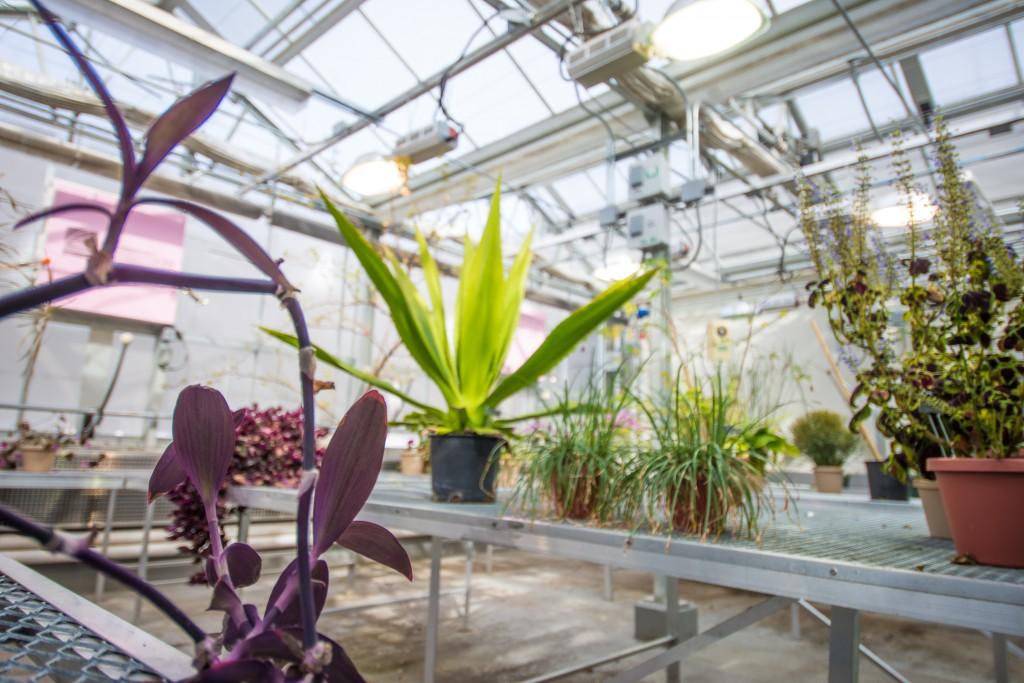On the third floor of the Noyce Science Center, an agave plant is about to bloom. Over the past several months it has grown over two meters, typically done before the plant actually flowers—an event that occurs just once every seven to 14 years. This agave now reaches the very top of the greenhouse’s glass ceiling.
The agave plant is just one of many residents of Grinnell’s greenhouse. And since its inception in 2007, the facility has also hosted students and faculty, as they engage in research, discovery and much more.
Though the current greenhouse has only been around for seven years, others existed before it. Most recently, Grinnell’s greenhouse was located at the east side of Noyce’s first floor. Its inconvenient location near the loading dock coupled with renovations to Noyce prompted the decision to move it. Vince Eckhart, Biology, stressed the advantages the new greenhouse has over the previous one.

Photo by John Brady.
“The new greenhouse has been fantastic compared to the old one in terms of even being able to do some of this research,” he commented.
Additionally, the third-floor location has the added advantage of more sunlight. Now it holds both permanent and temporary collections. Six modules house short-term experiments. In one room, seeds of various prairie plants germinate; in another, corn and soybean plants perch atop a table.
Two classes are currently utilizing the greenhouse this semester, which is almost at its capacity according to Greenhouse Manager Ashley Millet. Eckhart’s classes recently planted prairie seeds. And a class of Professor Ben DeRidder, Biology, currently works with the agricultural specimens. Eckhart and DeRidder, occasionally joined by MAP students, conduct their own research in the greenhouse, too.
“A lot of my lab time has been spent looking through microscopes,” said Tela Ebersole ’16, one of Eckhart’s students. “So, it’s really fun to do [research] … on a bigger scale.”
Over the years, the facility has also hosted non-science students. Art classes have also been able to take advantage of the facility.
“We want it to be a resource for teaching a little more broadly than biology,” Eckhart said.
To that end, some of the most visually fascinating specimens reside in the three modules that host the permanent collection. In one room, the agave towers over stocky cacti; in another, a vibrant hibiscus flower dangles from a branch. The collection, Eckhart explained, is certainly eclectic and useful for research.
“We deliberately brought [some plants] here because they’re valuable to us for teaching purposes,” he notes.
Millet and three student workers keep the current collection thriving. Maddie Howland ’16, for instance, attends to the plants in the greenhouse on a daily basis.
“I feel really lucky,” Howland said of her job. “There are a lot of beautiful plants up there and I hope to leave them in the best shape I can.”
Their work is not without its challenges, however.

Photo by John Brady.
“Our biggest challenge is pest control,” Millet revealed. “We do everything organically up here. So, we don’t spray anything to get rid of pests; we use ‘good bugs’ that will eat the ‘bad bugs.’”
Despite requiring more effort and time, going organic, Millet and Eckhart emphasized, has had its benefits. In the previous greenhouse, spraying chemicals made the facility off-limits to students and faculty for an entire day each week.
Making the facility more accessible presents its own obstacles. Eckhart cites safety concerns associated with the third-floor location. However, Millet wishes more students were aware of the greenhouse to begin with.
“[I] want to bring awareness that the greenhouse is here,” she said. “Unfortunately it’s P-Card access only, but if people contact me and want to come up here and have a tour … that would be great.”
Eckhart stresses, though, the greenhouse is an academic resource first—as he puts it, “It’s not [for] curiosity. It’s an academic facility.”
And in terms of providing a refuge from arctic vortices, Millet, Eckhart, Ebersole and Howland all agree, the greenhouse is unmatched.
Photos taken from the greenhouse can be found at http://www.flickr.com/photos/grinnellcollegegreenhouse/.



















































